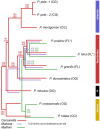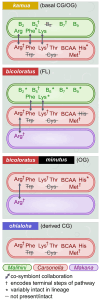Effect of Oceanic Islands on an Insect Symbiont Genome in Transition to a Host-Restricted Lifestyle
- PMID: 40711997
- PMCID: PMC12360927
- DOI: 10.1093/gbe/evaf153
Effect of Oceanic Islands on an Insect Symbiont Genome in Transition to a Host-Restricted Lifestyle
Abstract
Islands offer unique opportunities to study adaptive radiations and their impacts on host genome evolution. In Hawaiian Pariaconus psyllids, all species harbor the ancient nutritional symbiont Carsonella, while only free-living and open-gall species on younger islands host a second stable cosymbiont, Makana. In contrast, a third cosymbiont, Malihini, appears to be in an early stage of host restriction and genome degradation, making it a valuable model for understanding symbiont evolution during island radiations. Here, we examine Malihini genome evolution across multiple Pariaconus lineages using 16S rRNA sequencing, metagenomics, phylogenetic reconstruction, and microscopy. We find that Malihini is codiversifying with its hosts on the oldest island Kaua'i (kamua group; open- and closed-gall makers) and on the younger islands only in free-living species (bicoloratus group). Comparison of five Malihini genomes-including three newly assembled in this study-shows ongoing genome reduction from a large-genome ancestor (>3,900 protein-coding genes), likely driven by relaxed selection, vertical transmission bottlenecks, and island dispersal over the past 5 million years. On Kaua'i, the galling psyllids appear to depend more heavily on cosymbiont (Malihini) for the biosynthesis of amino acids and B-vitamins than galling species on younger islands-especially closed-gall species, which only have Carsonella. Surprisingly, free-living psyllids on younger islands with all three symbionts show metabolic reliance similar to Kaua'i gall makers. Together, our results demonstrate that island biogeography and host plant ecology shape symbiont losses and codiversification patterns. Malihini represents an early stage of symbiont genome degradation during host restriction, in sharp contrast to its more stable coresidents, Carsonella and Makana.
Keywords: Malihini; Pariaconus; Hawaiian Islands; adaptive radiation; genome evolution; symbiosis.
© The Author(s) 2025. Published by Oxford University Press on behalf of Society for Molecular Biology and Evolution.
Figures







Similar articles
-
Prescription of Controlled Substances: Benefits and Risks.2025 Jul 6. In: StatPearls [Internet]. Treasure Island (FL): StatPearls Publishing; 2025 Jan–. 2025 Jul 6. In: StatPearls [Internet]. Treasure Island (FL): StatPearls Publishing; 2025 Jan–. PMID: 30726003 Free Books & Documents.
-
An obligate symbiont of Haematomyzus elephantis with a strongly reduced genome resembles symbiotic bacteria in sucking lice.Appl Environ Microbiol. 2025 Jun 18;91(6):e0022025. doi: 10.1128/aem.00220-25. Epub 2025 May 14. Appl Environ Microbiol. 2025. PMID: 40366182 Free PMC article.
-
Coupled evolutionary rates shape a Hawaiian insect-symbiont system.BMC Genomics. 2025 Apr 3;26(1):336. doi: 10.1186/s12864-025-11514-z. BMC Genomics. 2025. PMID: 40181281 Free PMC article.
-
The Black Book of Psychotropic Dosing and Monitoring.Psychopharmacol Bull. 2024 Jul 8;54(3):8-59. Psychopharmacol Bull. 2024. PMID: 38993656 Free PMC article. Review.
-
Signs and symptoms to determine if a patient presenting in primary care or hospital outpatient settings has COVID-19.Cochrane Database Syst Rev. 2022 May 20;5(5):CD013665. doi: 10.1002/14651858.CD013665.pub3. Cochrane Database Syst Rev. 2022. PMID: 35593186 Free PMC article.
References
-
- Andrew S. FastQC: a quality control tool for high throughput sequence dataics—FastQC a quality control tool for high throughput sequence data. 2010. (accessed 2022 Mar 16). https://www.bioinformatics.babraham.ac.uk/projects/fastqc/.
-
- Appelhans T, Detsch F, Reudenbach C, Woellauer S. mapview: interactive viewing of spatial data in R. 2018. (accessed 2024 Feb 2). https://github.com/r-spatial/mapview.
-
- Bastin S, Reyes-Betancort JA, Siverio De La Rosa F, Percy DM. Origins of the central Macaronesian psyllid lineages (Hemiptera; Psylloidea) with characterization of a new island radiation on endemic Convolvulus floridus (Convolvulaceae) in the Canary Islands. PLoS One. 2024:19:e0297062. 10.1371/journal.pone.0297062. - DOI - PMC - PubMed
LinkOut - more resources
Full Text Sources
Miscellaneous

